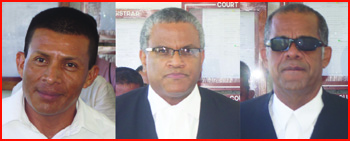 Who owns the Sarstoon Temash National Park? That is the question Justice Michele Arana is now trying to answer after counsels for SATIIM and surrounding Maya communities, U.S. Capital Energy and the Government of Belize concluded their presentations on Wednesday, October 23rd. It is a complex case, since arguments are based on a judgment currently under appeal, but the decision by Justice Arana will be based simply on the question of ownership.
Who owns the Sarstoon Temash National Park? That is the question Justice Michele Arana is now trying to answer after counsels for SATIIM and surrounding Maya communities, U.S. Capital Energy and the Government of Belize concluded their presentations on Wednesday, October 23rd. It is a complex case, since arguments are based on a judgment currently under appeal, but the decision by Justice Arana will be based simply on the question of ownership.
Senior Counsel Eamon Courtenay represents SATIIM and the four Maya communities that surround the Sarstoon Temash National Park. Courtenay presented his submissions on Tuesday, October 22nd. His case is based on a June 2010 ruling by Chief Justice Abdulai Conteh. In 2007, Conteh ruled that the villagers of Santa Cruz and Conejo were entitled to customary land tenure rights of their ancestral land. Then in a 2010 case he referred to as a sequel, Conteh ruled that all 33 Maya villages in the Toledo District have customary land tenure rights and government is obligated to protect those rights and ensure that such ownership is formally registered. The Government of Belize took the judgment to the Court of Appeals and in July of 2013 the Court upheld Conteh’s judgment that the Mayas have customary land tenure rights but rejected the order that Government must grant titles and do all in its power to enforce those rights.
Courtenay argues that it was unlawful for Government to grant an oil concession to U.S. Capital Energy for exploration in the Sarstoon Temash National Park since it is Maya ancestral land. Senior Counsel Denys Barrow, representing the Government of Belize, responded to Courtenay’s submissions on Wednesday, October 23rd. He spoke to the Guardian immediately after the case wrapped up. Barrow says, “The Mayas have not established that the lands they have any rights over include the lands where oil drilling activities have been authorized.” He continues, “They may have communal land rights, according to the Court of Appeals judgment-which is being appealed, but the judgment fails to state where those rights exist and where they are located.” He also says that nobody from the Maya communities have claimed that the place where the exploration activities are taking place is a sight where any of them used to hunt, fish farm or used to build anything.
Courtenay also requested that if the Court rules that Government acted lawfully in granting the oil concessions that the Court also orders for there to be “genuine consultations” his clients before drilling takes place. Barrow says the request for consultation is a complex one because Government has already sent Minister of Forestry, Fisheries and Sustainable Development, Hon. Lisel Alamilla, and Minister of Energy, Science and Technology, Hon. Joy Grant, into the communities to speak with residents of the surrounding areas. He says Government has also offered two percent of the five percent that Government would receive in the event of an oil discovery but they have rejected that offer.
All parties now await the ruling of Justice Arana. Greg Ch’oc, Executive Director of SATIIM, says he hopes the judgment will be delivered before U.S. Capital Energy move forward with its drilling operations. He says if the judgment is not delivered by that time then SATIIM will apply for an injunction to stop operations until a judgment is delivered. Barrow says that in the mean time the Maya communities should seek to reengage Government in order to benefit from the offer initially presented to them and maybe even lobby for a better deal.
Justice Arana has not set a date for judgment. A date has also not been set as yet for the Caribbean Court of Justice to hear the Maya communal land rights case. A ruling from the CCJ would make Justice Arana’s job much easier.




